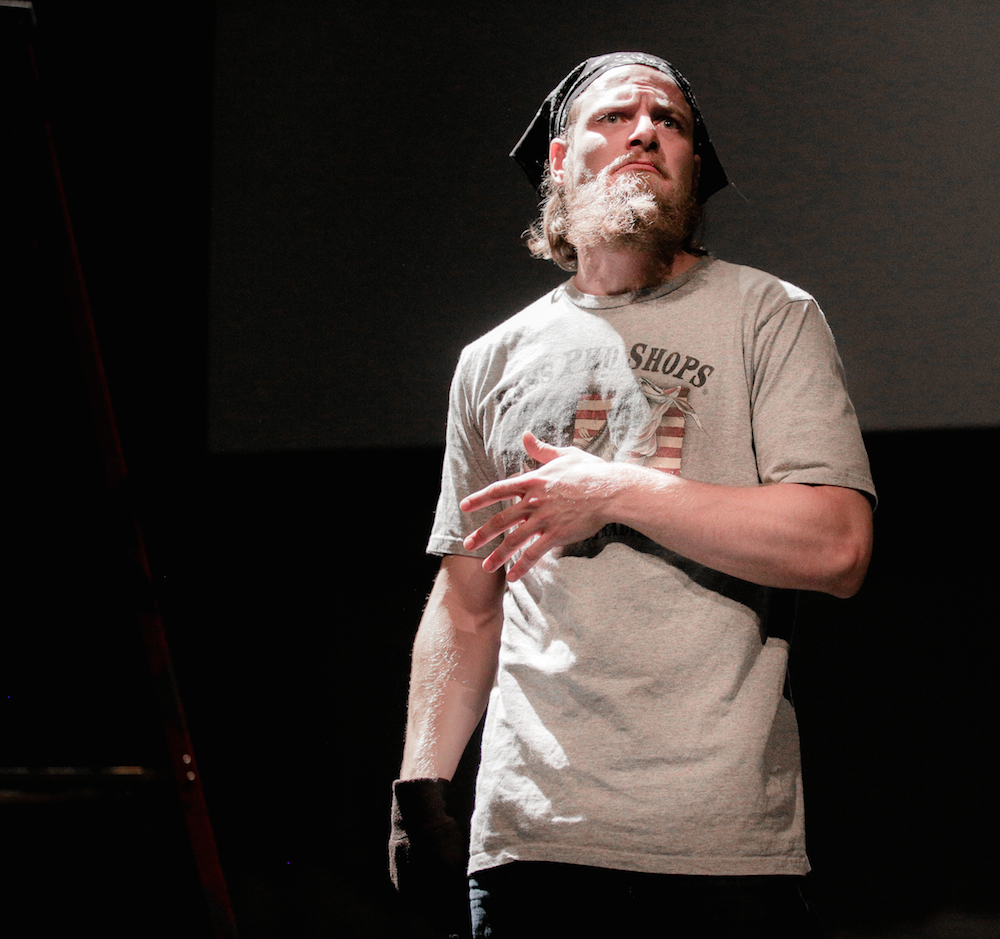
From the Center for Investigative Reporting’s StoryWorks. The play ‘North by Inferno’ is based on a CIR investigation and was performed in North Dakota in September. (Submitted photo)
For Jebadiah Stanfill, watching the play written about a deadly and devastating oil boom disaster was emotional, but it was also personal. When the scene came with the explosion, the screams, Stanfill had to leave the theater for a moment.
In September, the Center for Investigative Reporting’s StoryWorks took the story of their investigation into North Dakota’s Bakken oil boom onto the stage in North Dakota. CIR’s StoryWorks blends investigative journalism with theater produced in the impacted communities. Stanfill, a source in the story, saw the play’s first performance in Grand Forks.
To this day, the explosion – pieced together from interviews, court documents and federal and local reports – remains the worst accident in the expansive Bakken oil fields since the boom began in 2006.
Beyond the human toll from that day, which continues to haunt Stanfill and others, the 2011 explosion offers a striking illustration of how big oil companies have largely written the rules governing their own accountability for accidents.
— In North Dakota’s Bakken oil boom, there will be blood, Jennifer Gollan, Center for Investigative Reporting
All-access
StoryWorks began three years ago in a meeting between CIR’s Joaquin Alvarado and Tides Theatre’s Jennifer Welch. At the time, Welch was the producing artistic director for Tides, based in San Francisco. At first, they were just interested in co-hosting some events, Welch remembers, but out of that conversation, both groups got more and more interested in collaborating. Eventually, Welch pitched the idea of creating plays out of CIR’s investigative journalism. As they hammered out what such a collaboration could look like, Welch remembers CIR’s Executive Chair Phil Bronstein, the former editor of the San Francisco Chronicle, encouraging some risk taking.
If we aren’t pushing the journalism and if we aren’t taking artistic risks, she remembers him saying, then why the hell would we do this?
“The freedom to push those boundaries has been incredible,” Welch said.
She has learned she has to bring the journalists behind the investigations into the scriptwriting process early. Creating relationships is vital, she said. And the actors and directors need as much of that journalist’s source material as possible, including notes, transcripts and access to sources.
The artists involved feel responsibility to the story, she said.
“They’re representing real people, real stories, real tragedies,” said Welch, who is now StoryWorks’ director, “so for them I think it’s deeply fulfilling because they get a chance to create something beyond just the theater that we’re in.”
When CIR’s Jennifer Gollan got involved, she wasn’t sure what to expect at first.
“But I think they did a really good job and they worked very hard to make sure they got the details right,” she said.
The journalists are involved with the script as it’s written, making sure the facts line up with their stories and catching the artists up quickly on the intricacies of the story. And the story itself determines the style of the play.
“Dark Side of the Strawberry,” a play about fumigants on strawberry fields and the people exposed to those fumigants, came from what was really a piece about government regulations from CIR. Welch approached playwright Octavio Solis, and he created a stylized play after El Treatro Campesino, a style of play popular with labor rights activists that could be performed in the fields. That play included characters that were made up to tell the story.
“North by Inferno,” written by Jon Bernson, is deeply rooted in investigative journalism, Welch said. Collaborating with StoryWorks was a much more intensive project than Gollan could have imagined, she said, and it exceeded her expectations.
“It’s sort of constraining in one way but powerful in another in that they’re conveying what is a true life story.”
Talkback
Regardless of the style of the play, every performance ends with a “talkback,” offering the audience time to ask questions of the performers, sources and journalists. The talkbacks can run as long as the performance itself, Welch said.
“It’s a great way to again try to increase impact from the story,” Gollan said. “If people are moved to action, then we point them in the right direct as far as their local lawmakers so they know where they go to do something.”
With “Dark Side of the Strawberry,” StoryWorks also visited a high school surrounded by strawberry fields and spent two weeks in the classroom talking to students about the fumigants and helping them develop their own plays. With “North by Inferno,” StoryWorks performed twice in North Dakota, in communities impacted by the disaster Gollan reported on.
“You can open doors as artists that you can’t always open as journalists,” Welch said. “Art is a really personal and incredible way to communicate, and people are receptive to it, especially when you go to their community.”
Reach
CIR’s investigation into the Bakken oil boom was broadcast on the radio and PBS Newshour, the story ran on CIR’s site and Politico ran a shorter version. The play, Gollan said, helped it reach an even broader audience.
“We pride ourselves at CIR on multiplatform investigations, and I realized that this theater production was another aspect of that multiplatform approach,” she said.
The process brings something new to the stage, too. It normally takes one or two years to produce a play, Welch said. With StoryWorks, that’s condensed to a few months. And, she has learned, their two crafts aren’t quite so different from each other.
“What I didn’t realize going into it, and I think this was naive on my part, is we approach storytelling the same way,” Welch said. “In order to create a character, you want all sides of the story for them. You want a fully developed, fully realized character. In order to be an authentic reporter, you want all sides of the story.”
In the same way, she said, actors don’t judge their characters, they find out what motivates them.
“So we kind of start in the same place, and we’re committed to good storytelling, and we’re looking for strong narrative, so we weren’t that far away to begin with.”
Healing
“North by Inferno” debuts in California beginning Saturday and running for a week in Oakland. Another collaboration is planned next year in Kansas City.
For Gollan, watching a story she investigated come onto the stage in North Dakota was more emotional and powerful than she expected, she said, “because a lot of people in the audience were somehow connected to the oil industry.”
Seeing his own story on stage was emotional for Stanfill, too. But it has also helped him start to heal.
“I’m bad at describing emotions,” he said, “but I think that’s why I was able to have some closure. Before that, I hadn’t had a dream about something other than that fire for the past four years.”
So far, he said, he’s had two dreams of life outside that rig.









